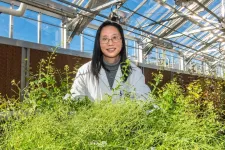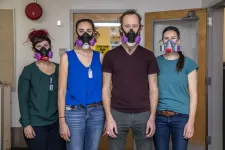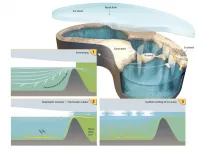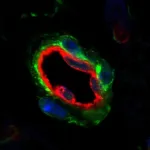(Press-News.org) UPTON, NY - Hundreds of naturally occurring specialty fatty acids (building blocks of oils) have potential for use as raw materials for making lubricants, plastics, pharmaceuticals, and more--if they could be produced at large scale by crop plants. But attempts to put genes for making these specialty building blocks into crops have had the opposite effect: Seeds from plants with genes added to make specialty fatty acids accumulated dramatically less oil. No one knew why.
Now two teams of biochemists working on separate aspects of oil synthesis at the U.S. Department of Energy's Brookhaven National Laboratory have converged to discover the mechanism behind the oil-production slowdown. As described in the journal Plant Physiology, they crossbred model plants and conducted detailed biochemical-genetic analyses to demonstrate a strategy for reversing the roadblock and ramping up production. The work paves the way for making at least one industrially important specialty fatty acid in plants--and may work for many others.
"Since scientists discovered the genes responsible for making specialty fatty acids several decades ago, we've dreamed of putting them into crop plants to make abundant renewable sources of desired fatty acids," said John Shanklin, chair of Brookhaven Lab's biology department, who oversaw the project. "But we've been stymied from using them because we didn't know why they dramatically slow fatty acid and oil synthesis. A number of research groups have been trying to figure out why this happens. We have now nailed down the mechanism and opened up the possibility of achieving that dream."
Two projects converge
This study grew out of two separate projects in Shanklin's biochemistry lab. One, led by Xiao-Hong Yu and Yuanheng Cai, was focused on the challenges associated with specialized fatty acid production in plants. The other, led by Jantana Keereetaweep, was deciphering details of the biochemical feedback loop plants use to regulate ordinary fatty acid and oil production.
Through that second project, the team recently characterized a mechanism by which plants down-regulate oil synthesis when levels of a plant's regular (endogenous) fatty acids get too high.
"This system operates like a thermostat," Shanklin explained. "When heat gets above its set point, the furnace turns off."
In the case of plant oils, the key machinery that controls production is an enzyme called ACCase. It has four parts, or subunits--you can think of them as gears. As long as endogenous fatty acids are below a certain level, the four "gears" mesh and the machine cranks out fatty acids for oil production. But feeding plants additional endogenous fatty acids triggers a substitution in the machinery. One of the ACCase subunits gets replaced by a version that isn't functional. "It's like a gear with no teeth," Shanklin said. That toothless gear (known as BADC) slows the fatty acid-producing machinery until endogenous fatty acid levels fall.
In contrast, the shutdown mechanism triggered by the specialty fatty acids (ones being produced by genes artificially added to the plant) kicks in when even small amounts of the "foreign" fatty acids are present, and endogenous fatty acids aren't in excess. "Because of this, they appeared to be two separate processes," Shanklin said.
But as the two teams discussed their projects, they began to wonder if the specialty fatty acids were triggering the same off switch triggered by high levels of ordinary fatty acids. "Imagine working in the same lab on different projects and in a lab meeting one day, you look at each other and ask, 'Is it possible we're working on the same thing?'" Shanklin said.
This idea provided a way for the teams to combine efforts on a new experiment.
Testing the hypothesis
Through earlier studies, Shanklin's group had created a strain of Arabidopsis (a model plant) that has two of its BADC genes deleted. In these plants, the off switch is disabled and the plants crank out high levels of endogenous fatty acids. They wondered what would happen if the BADC genes were disabled in plants engineered to produce specialty fatty acids.
To find out, Xiao-Hong Yu and Yuanheng Cai designed a strategy to crossbreed the defective off-switch plants with an Arabidopsis strain engineered to produce hydroxy fatty acids--one of the specialty types scientists would like to produce for industrial applications. This latter strain could make the hydroxy fatty acids, but its rate of oil synthesis was only half that of normal plants and it accumulated much less oil in its seeds.
When crossing four separate genetic factors, it takes several plant generations to produce plants with the desired combination of genes: both deleted BADC genes and two genes that drive the production of hydroxy fatty acids, with two identical copies of each genetic factor.
"We were fortunate to have two very dedicated students working as interns through Brookhaven's Office of Educational Programs--Kenneth Wei, who was then at Mount Sinai High School and is now at MIT, and Elen Deng, an undergraduate at Stony Brook University," Yu said. "They did fantastic work running polymerase chain reaction (PCR) tests--similar to those used to test for COVID-19--to run detailed analyses of more than 600 plants to find those with the desired genetic makeup."
Jantana Keereetaweep then worked with Yu to characterize those plants biochemically, to compare their rates of ACCase activity with those of the two Arabidopsis lines used to make the new genetic combinations.
The end result: Plants that had the combination of defective BADC genes and genes required for making hydroxy fatty acids produced normal levels of oil containing the specialty products. Compared with plants that had normal BADC genes, the new plants exhibited increases in the total amount of fatty acid per seed, the total seed oil content per plant, and the seed yield per plant.
"The BADC-defective plants are blind to the presence of hydroxy fatty acids and the usual response of turning off the ACCase--the oil-making machinery--is gone," Keereetaweep said.
The results prove that BADC is the mechanism for reducing ACCase activity in both scenarios--the accumulation of excess endogenous fatty acids and the presence of hydroxy fatty acid.
"We are now testing to see if this mechanism is limited to hydroxy fatty acids, or, as we suspect, common to other 'foreign' fatty acids that also reduce ACCase activity," Shanklin said. "If it's a general mechanism, it opens the possibility of realizing the dream of making additional desired specialty fatty acids in the oil-rich seeds of crop plants," Shanklin said.
"This is a good example where a fundamental mechanistic understanding of biochemical regulation can be deployed to enable progress towards a viable, sustainable bioeconomy," Shanklin said. "We can use this approach to make valuable renewable industrial starting materials at low cost in plants from carbon dioxide and sunlight, instead of relying on petrochemicals."
INFORMATION:
This study was supported by the DOE Office of Science and the National Science Foundation.
Brookhaven National Laboratory is supported by the U.S. Department of Energy's Office of Science. The Office of Science is the single largest supporter of basic research in the physical sciences in the United States and is working to address some of the most pressing challenges of our time. For more information, visit https://energy.gov/science .
Follow @BrookhavenLab on Twitter or find us on Facebook.
Related Links
Scientific paper: "Biotin Attachment Domain-Containing Proteins mediate hydroxy fatty acid-dependent inhibition of Acetyl CoA Carboxylase"
Removing the Brakes on Plant Oil Production
Plants' Oil-Production Accelerator Also Activates the Brakes
TAMPA, Fla. -- The prognosis of ovarian cancer is poor, with an estimated five-year survival of only 40% for advanced disease, the stage at which most ovarian carcinomas are diagnosed. These poor outcomes are partly due to the lack of effective therapies for advanced disease and recurrence. Immunotherapies hold promise for many types of cancer; however, studies have shown that patients with ovarian cancer do not have strong responses to existing drugs. In a new article published in Nature, Moffitt Cancer Center researchers demonstrate why some ...
There is an impassioned debate taking place in medicine on whether race-based considerations should be a factor in research, diagnoses, or treatments. Those on one side assert that race should be ignored entirely because it is a societal construct with no biological basis, and accordingly many hospitals are abandoning long-established "race corrections" in medical algorithms and diagnostics. Others, like Meghan McGarry, MD, MS, assistant professor of pediatrics at UC San Francisco, say that we can't completely ignore race, precisely because science is rarely free of societal influence - the structural inequality ...
Since element 99 - einsteinium - was discovered in 1952 at the Department of Energy's Lawrence Berkeley National Laboratory (Berkeley Lab) from the debris of the first hydrogen bomb, scientists have performed very few experiments with it because it is so hard to create and is exceptionally radioactive. A team of Berkeley Lab chemists has overcome these obstacles to report the first study characterizing some of its properties, opening the door to a better understanding of the remaining transuranic elements of the actinide series.
Published in the journal Nature, the study, "Structural and Spectroscopic Characterization of an Einsteinium Complex," was co-led by Berkeley Lab scientist Rebecca Abergel and Los ...
The Arctic Ocean was covered by up to 900 m thick shelf ice and was filled entirely with freshwater at least twice in the last 150,000 years. This surprising finding, reported in the latest issue of the journal Nature, is the result of long-term research by scientists from the Alfred Wegener Institute and the MARUM. With a detailed analysis of the composition of marine deposits, the scientists could demonstrate that the Arctic Ocean as well as the Nordic Seas did not contain sea-salt in at least two glacial periods. Instead, these oceans were filled with large amounts of freshwater under a thick ice shield. This water could then be released into the North Atlantic in very short periods of time. Such sudden freshwater inputs could explain rapid climate oscillations for which no satisfying ...
What The Study Did: Data from the Centers for Disease Control and Prevention were used to look at changes in emergency department visits for mental health, suicide attempts, drug and opioid overdoses and outcomes of violence before and during the COVID-19 pandemic.
Authors: Kristin M. Holland, Ph.D., M.P.H., of the Centers for Disease Control and Prevention in Atlanta, is the corresponding author.
To access the embargoed study: Visit our For The Media website at this link https://media.jamanetwork.com/
(10.1001/jamapsychiatry.2020.4402)
Editor's Note: Please see the article for additional information, ...
What The Study Did: COVID-19 outcomes including hospitalization and in-hospital death were compared between people living with or without diagnosed HIV in New York State.
Authors: Eli S. Rosenberg, Ph.D., of the State University of New York in Rensselaer, is the corresponding author.
To access the embargoed study: Visit our For The Media website at this link https://media.jamanetwork.com/
(doi:10.1001/jamanetworkopen.2020.37069)
Editor's Note: The article includes conflict of interest and funding/support disclosures. Please see the article for additional information, including other authors, author contributions and ...
Mechanism for control of antibiotic production in soil bacteria is visualised for the first time by scientists at University of Warwick and Monash University
Research reported in Nature could lead to improved manufacturing of existing antibiotics, and open up opportunities to discover new ones
The majority of clinically used antibiotics are derived from soil bacteria, but can be hard to find because their production is switched off in laboratory cultures
The discovery of how hormone-like molecules turn on antibiotic production in soil bacteria could unlock the untapped opportunities for medicines that are under our very feet.
An international team of scientists working at the University of Warwick, UK, and Monash ...
ANN ARBOR, Mich. - The suicide rate among American adolescents has rose drastically over the last decade, but many at-risk youths aren't receiving the mental health services they need.
In fact, one of the greatest challenges is identifying the young people who need the most help.
Now, researchers have developed a personalized system to better detect suicidal youths. The novel, universal screening tool helps caregivers reliably predict an adolescent's suicide risk - alerting them to which ones need follow-up interventions - according to Michigan Medicine-led findings published in JAMA Psychiatry.
"Too many young people are dying by suicide and many at high risk go completely unrecognized and untreated," says lead author Cheryl King, Ph.D., ...
CAMBRIDGE, MA -- Twenty years ago this month, the first draft of the human genome was publicly released. One of the major surprises that came from that project was the revelation that only 1.5 percent of the human genome consists of protein-coding genes.
Over the past two decades, it has become apparent that those noncoding stretches of DNA, originally thought to be "junk DNA," play critical roles in development and gene regulation. In a new study published today, a team of researchers from MIT has published the most comprehensive map yet of this noncoding DNA.
This map provides in-depth annotation of epigenomic marks -- modifications indicating which genes are turned on or off in different types of cells -- across 833 tissues and cell types, a significant increase over ...
DALLAS - Feb. 3, 2021 - Gaining more fat cells is probably not what most people want, although that might be exactly what they need to fight off diabetes and other diseases. How and where the body can add fat cells has remained a mystery - but two new studies from UT Southwestern provide answers on the way this process works.
The studies, both published online today in Cell Stem Cell, describe two different processes that affect the generation of new fat cells. One reports how fat cell creation is impacted by the level of activity in tiny organelles inside cells called mitochondria. The other outlines a process that prevents new fat cells from developing in one fat storage area in ...




